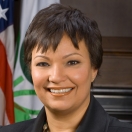
Ed. Note: As part Change.org's Blog Action Day, EPA Administrator Lisa P. Jackson reflects on the importance of protecting America's clean water supply.
When EPA was formed 40 years ago, water pollution was generally something that could be seen, touched, and smelled. We knew something was wrong when algae began to coat rivers, when the smell from untreated sewage reached our communities, or when massive fish kills appeared in lakes and streams. Perhaps the most famous example is the Cuyahoga River, which was so covered with pollution and industrial waste that in 1969 it literally caught fire.
Four decades later, we’ve seen considerable progress. The Clean Water and the Safe Drinking Water Acts have significantly reduced threats to our environment and our health. The widespread expansion of water infrastructure has brought clean, safe water to millions of Americans. And the Cuyahoga – along with a number of other water bodies – is cleaner than it has been in generations.
But this doesn’t mean we can take clean water for granted. While we have had success on traditional pollutants, there are other challenges to face in protecting America's waters today.
Contaminants and chemicals we’ve only recently had the science to detect move into our water supply from a variety of less-conventional places. Rather than gushing from the end of a pipe, pollution trickles from front lawns, city streets and parking lots. We can’t ask a single polluter to shut off its flow, so we have to find more creative solutions.
We’re working to find those solutions through efforts like our developing Urban Waters Initiative, and the Interagency Partnership for Sustainable Communities, in which EPA’s water protection investments will work in concert with housing and transportation investments from other agencies. We’re developing a strategy to incorporate green infrastructure into our clean water rules and actions, which will encourage strategies that work with nature – rather than against it – by using soil, vegetation, permeable materials and landscape changes to capture stormwater, filter contaminants, beautify communities, and reduce the runoff that flows into local waterways. We’ve issued clear guidance to protect Appalachian waters threatened by valley fills from mountaintop removal mining. And we’re working with the USDA and the agricultural community to reduce water impacts and encourage sustainable farming techniques.
Another issue we face is deferred maintenance in our infrastructure, which in too many communities is over-worked and under-budgeted. Our system is deeply stressed, our financial and our natural resources are limited and our needs are not negotiable.
The good news is that the Recovery Act provided almost $6 billion in funding for clean and drinking water projects. Those investments, along with EPA’s budget, comprise some of the strongest support for water infrastructure in recent memory. But if our water systems are going to work harder in the years ahead, we have to start working smarter today. Earlier this year I outlined a vision to improve drinking water protection by harnessing invention and innovation. I proposed enhancing efficiency by taking on water contaminants in groups, engaging innovators and entrepreneurs to develop new technology and using technology to improve information sharing and monitoring between federal, state and local authorities.
Finally, the BP spill has presented an unprecedented challenge as an emergency environmental response and a long-term restoration effort. I’m proud that President Obama has appointed me to lead the Gulf Coast Ecosystem Restoration Task Force. That single event has illustrated just how important clean water is to the health of our communities and our economy, and how entire ways of life count on clean water and a healthy environment. Those are the same reasons President Obama mobilized EPA and other federal agencies to revitalize cleanups in the Chesapeake Bay and the Great Lakes, and why we are recommitting to our work on other great waterbodies such as Puget Sound, Lake Tahoe, the San Francisco Bay Delta, as well as our oceans, estuaries and precious wetlands like the Florida Everglades.
Whether we face an immediate, emergency situation like the BP spill, or the gradual accumulation of challenges and degradation, our responsibilities to address the problems and find solutions are exactly the same. In each case, our efforts are focused on getting real, measurable results in the restoration of waterbodies that millions of people depend on.
In protecting America’s waters today, we have a responsibility to continue the work that began 40 years ago, and begin new work that will change the course of the next 40 years and beyond. This is what we have been doing since taking office, and what we plan on continuing to do in the months and years ahead.


